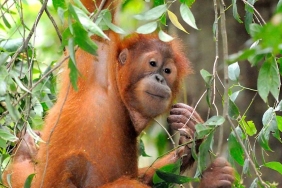THE FATE OF PROBOSCIS MONKEYS IN KALIMANTAN
Since the ice age melted, the proboscis monkey (Nasalis larvatus), this primate is trapped on the island of Borneo, this primate evolved differently from other primates on earth, a pointed nose shaped like a hanging bulb and long in size, also fat-bellied, proboscis monkeys eat a variety of leaves and fruit, in its body the leaves are cemented to produce natural immunity and a source of energy.
Proboscis monkeys live in mangrove forests, swamps and riparian areas that provide sufficient food plants for these animals. the natural conditions of the habitat of proboscis monkeys are in wetland areas such as peat swamp forests, mangroves, these animals are very dependent on riparian areas, namely the transition area between rivers and land, where this area has a distinctive character, because of the combination of aquatic, terrestrial and river environments, although a small part of the proboscis monkey population lives in dipterocarpaceae forests and kerangas forests on the banks of the river (Saltar et al. 1985 in Bismark 1995).
The area of proboscis monkey habitat is estimated to be 29,500 km2, of which 40% has been converted and only 4.1% is in conservation areas (McNeely 1990 in Bismark 1995). This endemic primate on the island of Borneo has an important role in maintaining the integrity of the ecosystem, especially wetland areas.
The proboscis monkey population was estimated in 1986 by McKinnon at 250,000 individuals, 25,000 of which were in conservation areas. Based on Yeager and Blondal (1992), the proboscis monkey in the conservation area is less than 5000 individuals while the proboscis monkey habitat in the conservation area is only 4.1 percent of all proboscis monkey habitat (McNeely et al., 1990). In 1994 the Bornean proboscis monkey population was estimated at 114,000 individuals (Bismark, 2009) and in the 2004 PHVA proboscis monkey count, the proboscis monkey population was estimated at 25,000 individuals, and those in conservation areas amounted to around 5,000 individuals.
Inadequate Role of Law and Conservation Action Plan
The natural enemy of the proboscis monkey is the clouded leopard (Neofelis diardi), this predatory animal controls the proboscis monkey population in the wild, another enemy is humans, proboscis monkeys are still hunted in certain areas of Kalimantan, proboscis monkeys are still often used by the community as a source to meet animal protein needs (subsistence), in addition to other things by making proboscis monkey meat as a potent bait for hunting labi-labi (freshwater turtles) and other hunting for trade.
Another biggest enemy for proboscis monkeys is habitat destruction, conversion of natural forests and habitat fragmentation driven by policies to open mining and mangrove land, the condition of the proboscis monkey population can be extinct, if there is no serious effort to protect it by the Government, this is due to the increasing threat of habitat destruction and rampant hunting, this is as experienced by other endangered animals in Indonesia, legal protection for proboscis monkeys is still biased, even though there is a Law, namely Law Number 5 of 1990 concerning Conservation of Nature and ecosystems and there has been a Strategy and Action Plan for Proboscis Monkey Conservation 2013-2022 that has been prepared by the Government.
But this action is again difficult to implement, this regulation is constrained by human resources and has not touched the root of the problem of proboscis monkey conservation, proboscis monkey habitat is outside the conservation area, as a result of increasingly narrow habitat and hunting, not to mention that proboscis monkeys are still considered unimportant by the government, proboscis monkeys are not made the main consideration of a regional development plan in supporting sustainable development.
The loss of habitat and population of proboscis monkeys in an area in Kalimantan seems to have been considered as a normalcy and the consequence is the orientation of development for economic interests and ignoring aspects of biodiversity conservation.
Probate Conservation Efforts
Proboscis monkeys play an ecological role in the wild in maintaining the ecosystems that are their habitat, to ensure the availability of ecosystem services to support human welfare. The largest service of proboscis monkeys is the formation of forests in wetland areas and mangrove areas in Kalimantan. Proboscis monkeys regulate forest silviculture by eating the leaves and shoots of plants, so that plants grow in a complex manner.
From a formal legal aspect, it already exists and helps prevent proboscis monkeys from threats as well as law enforcement efforts against illegal hunting and trade of proboscis monkeys, as well as against illegal acts of destruction and removal of their habitat, can be done optimally by increasing protection of proboscis monkeys by conducting patrols by the forestry police in collaboration with layers of the community and the management of mangrove forests and wetlands, thus, conservation of proboscis monkeys must be carried out in an integrated manner by carrying out various effective methods, including with a moral approach by involving all parties with an interest in this unique primate.
Some solutions for conservation are, first, the designation of a special protection area for proboscis monkeys, conservation efforts that are also possible are to designate several areas of relatively safe proboscis monkey habitat as proboscis monkey protection areas and begin limited tourism activities to walk through mangrove areas while observing proboscis monkeys can be done special research tours for local, national and international students.
Second, socialization for the community is carried out to convey about the condition of biodiversity in the vicinity, three community-based ecotourism development, the management concept will directly provide economic benefits to local communities, current tourism interest leads to the utilization of proboscis monkeys in the wild and can be seen naturally so that potential ecotourism. The existence of proboscis monkeys can be the main attraction of ecotourism ex-situ conservation activities can be made throughout Kalimantan and aims to capture / restock proboscis monkeys in nature.
The loss of proboscis monkeys can also have an impact on the decline in wetland quality, naturally also the loss of proboscis monkeys also has an impact on the decline in the Borneo clouded leopard population, proboscis monkeys are unique primates in Kalimantan which symbolize good and healthy forests in Kalimantan.
Written by: Azhar
Alumnus of TGK Chik Pantee Kulu College of Forestry Banda Aceh





